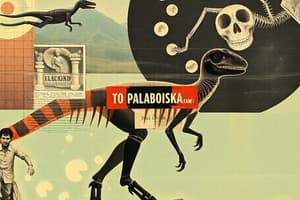Podcast
Questions and Answers
What does the prefix 'palaeo' signify in paleontology?
What does the prefix 'palaeo' signify in paleontology?
- Recent development
- Evolution of species
- Ancient or of past times (correct)
- Study of plants
Which of the following is NOT a subdiscipline of paleontology?
Which of the following is NOT a subdiscipline of paleontology?
- Vertebrate paleontology
- Invertebrate paleontology
- Evolutionary paleontology (correct)
- Microbial paleontology
What main approaches do paleontologists use to study ancient animals?
What main approaches do paleontologists use to study ancient animals?
- Studying only fossils
- Analyzing genetic material of modern organisms
- Studying only modern animals
- Examining living animals and studying fossils (correct)
Which of the following accurately describes an invertebrate?
Which of the following accurately describes an invertebrate?
Which aspect of paleontology is not mentioned in its relationship with other sciences?
Which aspect of paleontology is not mentioned in its relationship with other sciences?
What did ancient Greek philosopher Xenophanes conclude based on fossil evidence?
What did ancient Greek philosopher Xenophanes conclude based on fossil evidence?
What do paleontologists study apart from fossils?
What do paleontologists study apart from fossils?
In paleontology, the philosophical study of the nature of being is referred to as what?
In paleontology, the philosophical study of the nature of being is referred to as what?
Which type of trace reflects maximum utilization of the surficial feeding area?
Which type of trace reflects maximum utilization of the surficial feeding area?
What characteristic is typically not found in the structures classified as Fodichnia?
What characteristic is typically not found in the structures classified as Fodichnia?
What behavior do grazing traces (Pascichnia) exhibit that is analogous to a mining technique?
What behavior do grazing traces (Pascichnia) exhibit that is analogous to a mining technique?
What is the primary method paleontologists use to date fossils?
What is the primary method paleontologists use to date fossils?
What is a common feature of structures classified under Fodichnia?
What is a common feature of structures classified under Fodichnia?
Which trace structure is characterized by cylindrical forms and may provide shelter for organisms?
Which trace structure is characterized by cylindrical forms and may provide shelter for organisms?
Which statement accurately describes stratigraphy?
Which statement accurately describes stratigraphy?
What is the significance of index fossils in biostratigraphy?
What is the significance of index fossils in biostratigraphy?
What limitation does stratigraphy have in dating fossils?
What limitation does stratigraphy have in dating fossils?
How can family-tree relationships assist in estimating the age of lineages?
How can family-tree relationships assist in estimating the age of lineages?
What is a molecular clock and its limitation?
What is a molecular clock and its limitation?
What consequence can arise from index fossils having longer ranges than initially proposed?
What consequence can arise from index fossils having longer ranges than initially proposed?
Why might estimating the timing of the Cambrian explosion be challenging?
Why might estimating the timing of the Cambrian explosion be challenging?
What inference can be made from the small size of the fish fossils?
What inference can be made from the small size of the fish fossils?
Which observation indicates that fossil deposits were formed close to a body of water?
Which observation indicates that fossil deposits were formed close to a body of water?
What does the presence of marine fossils in high mountains like the Himalayas indicate?
What does the presence of marine fossils in high mountains like the Himalayas indicate?
What does the occurrence of fossils of different ages at adjacent localities suggest?
What does the occurrence of fossils of different ages at adjacent localities suggest?
Why were the similarities in fossil assemblages across continents surprising?
Why were the similarities in fossil assemblages across continents surprising?
What does the presence of marine fossils in cliffs around Port Phillip Bay indicate?
What does the presence of marine fossils in cliffs around Port Phillip Bay indicate?
Which factor does NOT support interpretations of ancient geography based on fossils?
Which factor does NOT support interpretations of ancient geography based on fossils?
How do fossils help indicate past movements of the Earth's crust?
How do fossils help indicate past movements of the Earth's crust?
What are stromatolites primarily characterized by?
What are stromatolites primarily characterized by?
Which category of ichnofossils is specifically associated with locomotion?
Which category of ichnofossils is specifically associated with locomotion?
What type of characteristics do resting traces exhibit?
What type of characteristics do resting traces exhibit?
Which of the following best describes the morphology of crawling traces?
Which of the following best describes the morphology of crawling traces?
What do endolithic bivalves primarily leave behind?
What do endolithic bivalves primarily leave behind?
Which type of fossils are not included in the ethological classification scheme mentioned?
Which type of fossils are not included in the ethological classification scheme mentioned?
What distinguishes resting traces from other trace fossils?
What distinguishes resting traces from other trace fossils?
Which option accurately describes the morphology that can include branching and horizontal structures?
Which option accurately describes the morphology that can include branching and horizontal structures?
Flashcards are hidden until you start studying
Study Notes
Paleontology Overview
- Paleontology studies the life of past geological ages, encompassing more than just fossils.
- Key components of paleontology:
- Paleo: Indicates ancient or primitive nature.
- Ontology: Philosophical study of being and existence, categorizing entities and their relations.
- Divided into two subdisciplines:
- Invertebrate Paleontology: Studies animals without spinal columns.
- Vertebrate Paleontology: Focuses on animals with spinal columns.
Methods of Study
- Evidence sources include:
- Examination of modern animals to understand evolution and relationships.
- Analysis of fossils which can be physical remains or trace fossils (e.g., tracks, burrows).
- Paleontology connects life sciences with earth sciences, aiding in:
- Sediment dating.
- Reconstructing ancient environments.
- Testing plate tectonics models.
Historical Context
- Established around 1800; earlier considerations of fossils date back to ancient Greek philosopher Xenophanes, who noted fossilized seashells indicating previous marine environments.
Fossils and Earth Movements
- Fossils can indicate geological movements such as slight land uplift or significant displacement.
- Example: Marine fossils found in cliffs or distant from oceans indicate past geological changes.
- Faults may be identified by fossils of differing ages appearing adjacent, as seen in the Whitelaw Fault with varying Ordovician fossil ages.
Fossils and Ancient Geography
- Similar fossil assemblages in disparate continents suggest historical connections beyond migration.
- Stratigraphy: A method used for dating fossils by understanding sediment layers.
- Biostratigraphy: Links isolated rock sequences through index fossils to establish relative dating.
Dating Techniques
- Family-tree relationships help date lineage evolution; older ancestor fossils suggest earlier existence.
- Molecular clocks estimate divergence times of living clades based on DNA mutation rates, but results can vary significantly.
Trace Fossils and Ethological Classification
- Different types of trace fossils:
- Resting traces (Cubichnia): Shallow depressions indicating animal presence.
- Crawling traces (Repichnia): Pathways and tracks illustrating movement.
- Grazing traces (Pascichnia): Marks of feeding behavior at the substrate surface.
- Feeding traces (Fodichnia): Temporary burrows or structures created by feed behaviors.
Stromatolites
- Understand formation, morphology, and environmental significance of stromatolites.
Studying That Suits You
Use AI to generate personalized quizzes and flashcards to suit your learning preferences.





